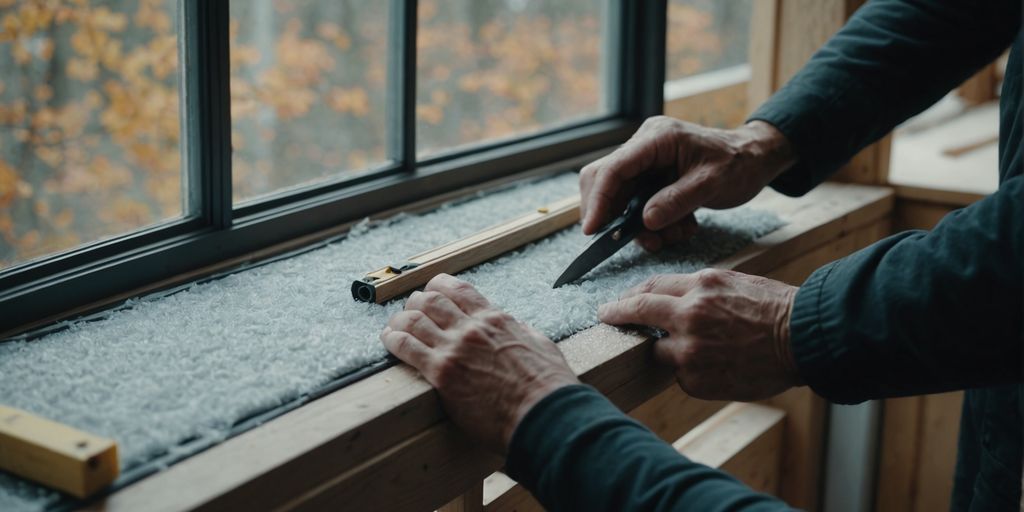
How to Install and Maintain a Window Seal for Maximum Insulation
Keeping your home cozy while saving on energy bills is easier than you think. One of the best ways to do this is by installing and maintaining window seals. This guide will walk you through the process of choosing the right materials, installing them correctly, and keeping them in top shape. Let's dive in and make your home more comfortable and energy-efficient!
Key Takeaways
- Choosing the right materials for window seals is crucial for effective insulation.
- Proper installation of window seals involves careful preparation and application.
- Regular maintenance of window seals ensures long-lasting insulation benefits.
- Additional insulation techniques like spray foam and draft stoppers can enhance window efficiency.
- Avoiding common mistakes during installation and maintenance can save time and money.
Choosing the Right Window Seal Materials
Types of Window Seals
When it comes to window seals, there are several types to choose from. Each type has its own benefits and is suitable for different situations. Here are some common types:
- Foam Stripping: Ideal for the top and bottom of the window sash. It is strong and durable but can be tricky to install.
- Tape Stripping: Easy to install and cost-effective, perfect for window sashes.
- Vinyl Stripping: Best for holding moisture and works well inside the track of double-hung or sliding windows. It is durable and easy to install.
- Fin Seal: Great for aluminum sliding windows. It is slightly more expensive and can be difficult to install but is very effective in keeping the cold out.
- Felt: Easy to install and inexpensive but not very efficient. Suitable for areas with low friction around a window.
Benefits of Different Materials
Different materials offer various benefits. Here’s a quick look at some of them:
- Foam: Provides excellent insulation and is moderately priced.
- Tape: Very simple to install and low-cost.
- Vinyl: Durable and invisible once installed, making it a great choice for moisture-prone areas.
- Fin Seal: Highly effective in minimizing air, wind, and water infiltration.
- Felt: Best for low-friction areas and is very easy to install.
How to Measure for a Perfect Fit
Getting the right fit is crucial for effective insulation. Here’s how you can measure for a perfect fit:
- Measure the Window Frame: Use a tape measure to get the dimensions of your window frame.
- Choose the Right Material: Based on your measurements, select the material that best suits your needs.
- Cut to Size: Carefully cut the material to fit the dimensions of your window frame.
- Test the Fit: Before final installation, test the fit to ensure it’s snug and secure.
Tip: Always double-check your measurements to avoid any mistakes. A perfect fit ensures maximum insulation and efficiency.
Step-by-Step Guide to Installing Window Seals
Preparing the Window Frame
Start by cleaning the window frame. Use a sharp knife or paint scraper to remove any old paint or caulking. Wipe away any residue with a damp cloth and let it dry completely.
Applying the Sealant
Load your caulking gun with silicone caulk. Hold the gun at a 45-degree angle and fill the cracks in the window frame. Release the trigger before pulling the gun away to avoid excess caulk. If the caulk shrinks, reapply until a smooth bead is formed. Use a putty knife to even out the caulk and let it dry for 24 hours.
Ensuring a Tight Fit
After the caulk has dried, measure and cut the weatherstripping to fit your window. Peel off the adhesive backing and press the weatherstripping firmly onto the window frame. For a tight fit, use a putty knife to press it in place. If you want extra protection, consider using a product like the "wrs weather stripping glazing channel 1/2" - 50ft roll". This type of weatherstripping is designed to reduce air, wind, and water infiltration, making it ideal for various window types.
Maintaining Your Window Seals
Regular Inspections
To keep your window seal in top shape, it's important to inspect it regularly. Look for any signs of wear and tear, such as cracks or gaps. If you notice any issues, address them immediately to prevent further damage. Regular checks can help you catch problems early and save on costly repairs.
Cleaning Tips
Keeping your window seals clean is essential for their longevity. Use a mild soap and water solution to gently clean the seals. Avoid using harsh chemicals that can damage the material. After cleaning, make sure to dry the seals thoroughly to prevent mold and mildew growth.
When to Replace
Even with regular maintenance, window seals will eventually need to be replaced. If you notice persistent drafts, increased energy bills, or visible damage that can't be repaired, it might be time for a replacement. Weather stripping and other materials can wear out over time, so keep an eye on their condition.
Regular maintenance of your window seals not only extends their life but also ensures your home remains energy-efficient and comfortable.
Additional Insulation Techniques for Windows
To maximize the insulation of your windows, consider these additional techniques. These methods can help you save on energy bills and keep your home comfortable year-round.
Using Spray Foam Insulation
Spray foam insulation is a great way to seal gaps and cracks around your windows. It expands to fill even the smallest spaces, providing a tight seal. Be sure to use low-expansion foam to avoid warping the window frame. Keep a solvent like WD-40 handy to clean up any excess foam.
Installing Draft Stoppers
Draft stoppers are simple yet effective. These fabric tubes filled with insulating materials are placed at the base of your windows to block cold air from entering. They are an affordable solution and can even be homemade.
Adding Window Treatments
Window treatments can significantly improve your window insulation. Here are some options:
- Cellular Shades: These shades have air pockets that reduce heat conduction. They can be folded when not in use.
- Draperies: Made of thick fabric, draperies can block a lot of heat, especially those with white backings.
- Blinds: Reflective blinds are effective in reducing solar heat gain. However, they are less effective in winter as they can't fully block heat loss.
For maximum insulation, tightly fit shades can reduce heat loss by up to 40%, translating to significant energy savings.
By using these additional insulation techniques, you can enhance the energy efficiency and comfort of your home.
Common Mistakes to Avoid When Sealing Windows
Sealing windows is a crucial step in ensuring your home remains energy-efficient and comfortable. However, there are common mistakes that many people make during this process. Avoiding these errors can save you time, money, and effort in the long run.
Overlooking Small Gaps
One of the most frequent mistakes is overlooking small gaps around the window frame. Even tiny openings can let in drafts, reducing the effectiveness of your insulation. Make sure to inspect every corner and seal even the smallest gaps to ensure maximum insulation.
Using the Wrong Type of Sealant
Not all sealants are created equal. Using the wrong type of sealant can lead to poor adhesion and reduced effectiveness. For instance, some sealants are designed specifically for aluminum or vinyl windows and offer superior weatherability and chemical resistance. Always choose a sealant that is appropriate for your window material.
Ignoring Maintenance
Sealing your windows is not a one-time job. Over time, the sealant can wear out due to weather conditions and general wear and tear. Regular inspections and maintenance are essential to keep your windows properly sealed. Ignoring this can lead to air, wind, and water infiltration, compromising your home's insulation.
Regular maintenance and choosing the right materials can significantly improve the longevity and effectiveness of your window seals.
Benefits of Properly Sealed Windows
Energy Efficiency
Properly sealed windows are essential for maintaining energy efficiency in your home. By preventing drafts and air leaks, you can significantly reduce the amount of energy needed to heat or cool your living space. This not only helps the environment but also lowers your monthly energy bills.
Enhanced Comfort
Sealing your windows ensures a consistent indoor temperature, making your home more comfortable year-round. No more chilly drafts in the winter or hot spots in the summer. A well-sealed window keeps the indoor climate stable, enhancing your overall comfort.
Noise Reduction
Another great benefit of properly sealed windows is noise reduction. The seal acts as a barrier, blocking out unwanted external noise. This is especially useful if you live in a noisy neighborhood or near a busy street. Enjoy a quieter, more peaceful living environment with well-sealed windows.
Properly sealed windows not only improve energy efficiency but also enhance comfort and reduce noise, making your home a better place to live.
Conclusion
Installing and maintaining window seals for maximum insulation is a straightforward yet crucial task for enhancing your home's energy efficiency. By following the steps outlined, you can effectively seal gaps and cracks, preventing unwanted drafts and temperature fluctuations. Regular maintenance, such as reapplying caulk and checking weatherstripping, ensures that your window seals remain effective over time. Not only does this help in keeping your home comfortable, but it also leads to significant savings on your energy bills. Remember, a well-insulated home is not just about comfort; it's also about being environmentally responsible and cost-efficient. So, take the time to properly install and maintain your window seals, and enjoy the benefits of a cozier, more energy-efficient home.
Frequently Asked Questions
What are the best materials for window seals?
The best materials for window seals include silicone, foam, vinyl, and felt. Silicone is durable and flexible, foam offers good insulation, vinyl is moisture-resistant, and felt is easy to install.
How often should I replace window caulking?
Window caulking should be replaced every one to two years. Weather changes can cause it to crack and wear out, so regular maintenance is important to keep your home insulated.
Can I use high-expansion foam for window insulation?
It's better to use low-expansion foam for window insulation. High-expansion foam can expand too much and make it hard to open or close your windows.
How do I measure for new window seals?
To measure for new window seals, use a tape measure to find the length and width of the window frame. Make sure to measure the inside edges where the seal will be applied.
What are draft stoppers and how do they work?
Draft stoppers are long tubes filled with materials like rice or beans. They are placed at the base of windows to block cold air from entering and warm air from escaping.
How can I tell if my window seals need replacing?
You should inspect your window seals regularly. If you notice drafts, condensation between panes, or visible cracks and gaps, it's time to replace the seals.
